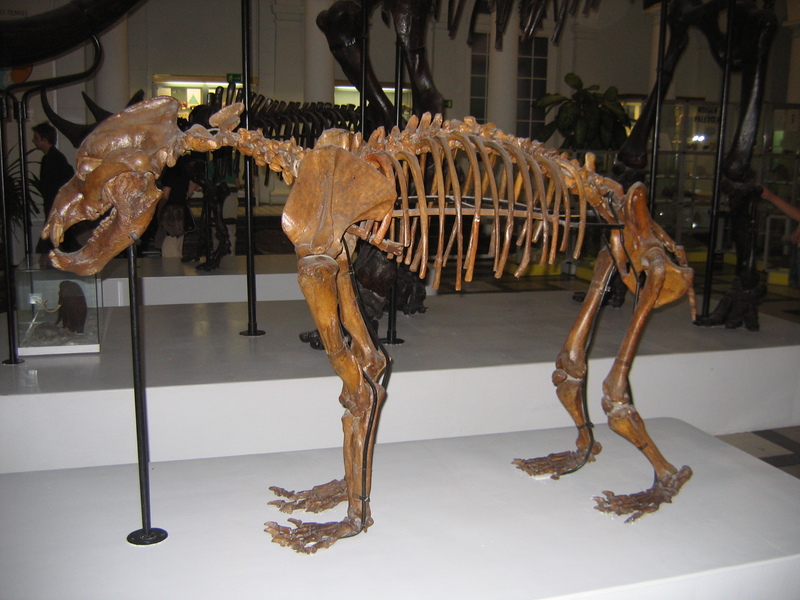| 새로운 사진 | 신문속의 동물소식 | 신기한 동물이야기 | 동물의 소리 | 동물동화상 | 사진 올리기 | 사진 저작권 | English |
|---|
| 재미있는 동물사진 | 괴수/괴어/엽기 동물사진 | 동물이름사전 | 동물목록 | 바깥고리 | 창고입구 | 똑똑누리집 |
|---|
| 이미지 정보 | Original File Name: Niedzwiedz_jaskiniowy_pl-Cave Bear (Ursus spelaeus) skeleton.jpg Resolution: 2048x1536 File Size: 1297876 Bytes Date: 2007:05:19 20:41:23 Camera: Canon PowerShot A95 (Canon) F number: f/2.8 Exposure: 1/60 sec Focal Length: 250/32 Upload Time: 2008:01:08 09:35:03 | |
| 올린이 | 이름 (메일주소): Unknown | |
| 사진 제목 | Cave Bear (Ursus spelaeus) - Wiki | |
 |
| Email : 카드 | 올린이 | 운영자 사진삭제 정보수정 Admin |
| 설명 | Cave Bear (Ursus spelaeus) - Wiki
Cave bear
The Cave Bear (Ursus spelaeus) was a species of bear which lived in Europe during the Pleistocene and became extinct at the end of the last ice age about 20,000 years ago. Both the name Cave Bear and the scientific name spelaeus derive from the fact that fossils of this species were mostly found in caves, indicating that this species spent more time in caves than the Brown Bear, which only uses caves for hibernation. Consequently, in the course of time, whole layers of bones, almost entirely those of cave bears, were found in many caves. Many caves in Europe have skeletons of cave bears on display, for example the Heinrichsh??hle in Hemer or the Dechenh??hle in Iserlohn, Germany. In Romania, there is a cave called Pe??tera Ur??ilor (Bears' Cave) where 140 cave bear skeletons were discovered in 1983. Being about 30% bigger than the Brown Bear, the most notable difference between the two species is the steeper forehead of the cave bear. It was an omnivore, primarily eating herbs, grass, and berries and occasionally honey. In the summer, particularly, it lived entirely on a plant diet. For that reason, it was not a Eurasian equivalent of the tall, lean Arctodus, as the latter was far more carnivorous, though the weight was about the same. The change of climate at the end of the W??rm Ice Age changed the flora significantly; however it was far from the first time an ice age had ended, and a human role in the extinction is possible. The cave bear was hunted intensively by early Paleolithic hunters, but it most likely was not they who primarily endangered its existence. Cave bears were affected much more adversely by reduction of the forests in the last glacial period. The cold, grassy steppe did not provide them with sufficient sustenance, and they died out. It is suspected that cave bears were worshipped by some prehistoric Europeans, and shrines and altars have been found with cave bear-like carvings. A fictional interpretation of such worship can be found in Jean M. Auel's novel The Clan of the Cave Bear. In May 2005, scientists in California succeeded in recovering and decoding DNA of a cave bear that lived between 42,000 and 44,000 years ago. The procedure used genomic DNA extracted from the animal's tooth, made use of powerful new computing technology developed for the human genome project. Sequencing the DNA directly (rather than first replicating it with the polymerase chain reaction), the scientists were able to recover 21 cave bear genes. In Popular Culture In the second episode of ITV's Prehistoric Park, Nigel Marven encountered a cave bear while trying to rescue a woolly mammoth. The Cave Bear is a central figure in The Earth's Children books, these were written by Jean M. Auel. http://en.wikipedia.org/wiki/Cave_bear
| |||
| 저작권 정보 | 사진의 저작권은 원저작자에게 있습니다. 동물그림창고는 동물관련 사진을 전시할 수 있는 공간만을 제공합니다.사진을 사용하고자 할 경우에는 저작권자와 협의하시기 바랍니다. |
|
|
|
| |||||||
| CopyLeft © since 1995, 동물그림창고. All rights may be reserved. | ||||||||
Stats